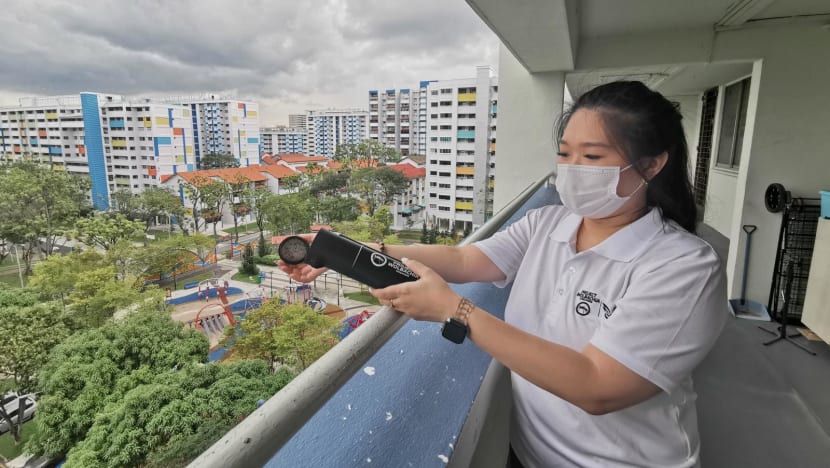Wolbachia mosquitoes to be released at 5 new sites in Singapore to tackle dengue
The five locations are Serangoon Central, Serangoon North, Jurong East, Jurong West and an expansion of an existing study site in Hougang.

An NEA field officer releasing male Wolbachia-Aedes mosquitoes at an HDB block. (File photo: NEA)

This audio is generated by an AI tool.
SINGAPORE: Male Wolbachia-carrying mosquitoes will be released at five additional sites to suppress the aedes mosquito population and mitigate the risk of dengue outbreaks, announced the National Environment Agency (NEA) on Thursday (Oct 3).
The five locations are Serangoon Central, Serangoon North, Jurong East, Jurong West and an expansion of an existing study site in Hougang.
According to NEA, the sites were selected based on the risk of dengue transmission, including an abundance of Aedes mosquitoes.
Under Project Wolbachia, male Aedes aegypti mosquitoes that carry the Wolbachia bacteria are released to mate with the female Aedes aegypti in an urban environment. The resulting eggs do not hatch.
Male mosquitoes do not bite and cannot transmit disease as they feed only on plant juices such as nectar.
Releases, which will be conducted twice a week, begin this quarter for the sites in Serangoon and Hougang, while the two remaining sites in Jurong will begin the releases in the first quarter of next year.
The new sites will increase Wolbachia coverage from 480,000 households to 580,000.





The expansion comes after NEA saw an 80 to 90 per cent drop in the Aedes aegypti mosquito population in its multi-site field study.
The two-year study, which started in Jul 2022, was designed to determine the impact of the Wolbachia technology on dengue cases and clusters on top of its effect on the aedes population. As part of the study, Wolbachia mosquitoes are being released at sites including Bedok, Choa Chu Kang and Punggol.
Initial results from the study indicate that residents living in these sites are about 75 per cent less likely to be infected with dengue, said NEA.
Speaking to reporters at a community event on Thursday, Sustainability and the Environment Minister Grace Fu said the average monthly number of dengue cases has reduced from 3,000 cases from 2022 - when Singapore experienced a dengue outbreak - to 1,300 this year.
“That is a very encouraging sign. So we want to continue and expand the Project Wolbachia but obviously, this is not a silver bullet. We still need residents to adopt good housekeeping practices to keep mosquito breeding to the minimum.”
She added that NEA still needs to complete the study and look at the cost benefit, the effectiveness and capacity of the project.
“We have to conclude the study so that we can compare the results. So it's not just about number of (dengue) cases, because the number of cases is also dependent on issues such as (the) weather and … whether we have an outbreak,” she said.
“We want to do the study properly because obviously, (it) involves investments into the production capability.”

According to data from the NEA website, more than 12,000 dengue cases have been recorded this year, exceeding the total number recorded in the whole of 2023.
NEA had already warned in March this year of an increase in dengue infections, with over 5,000 cases reported in the first quarter of 2024, more than double the 2,360 cases reported in the same period in 2023.
A total of 152 dengue cases were reported in the week ending Sep 28. As of Thursday, there were 34 active dengue clusters. Nine are considered red-alert clusters, which indicate high-risk areas with 10 or more cases each.










.png?itok=KBdatgH6)






